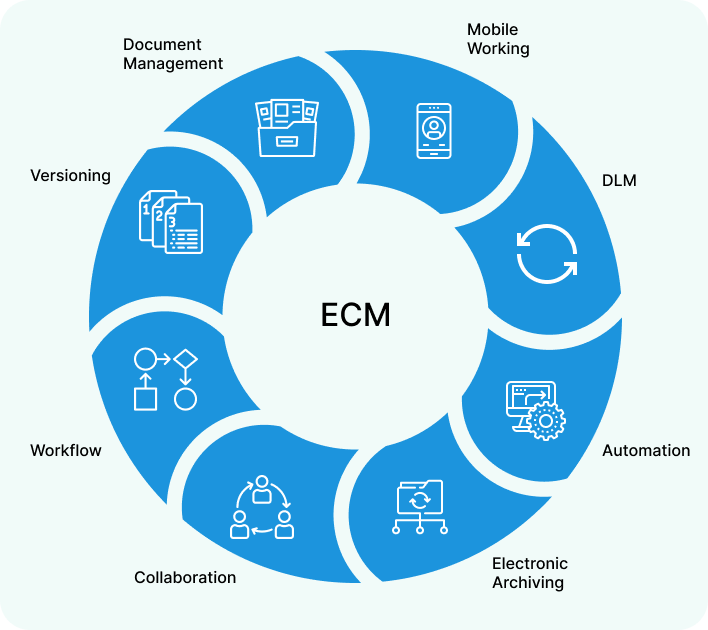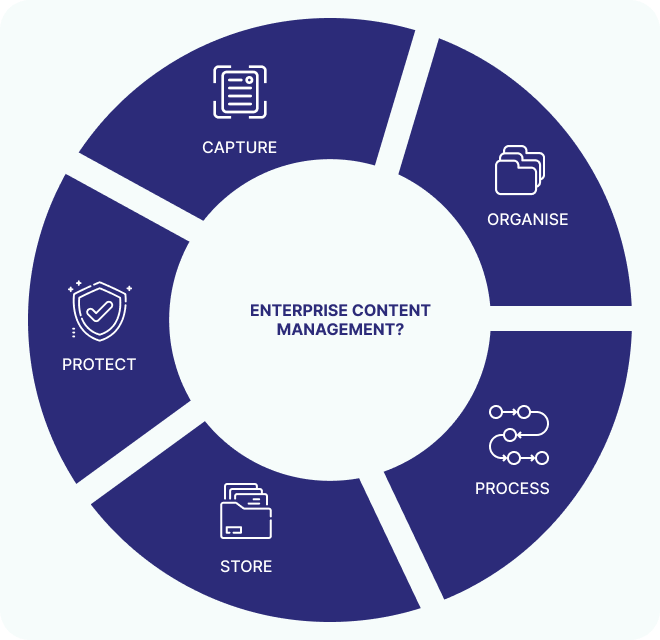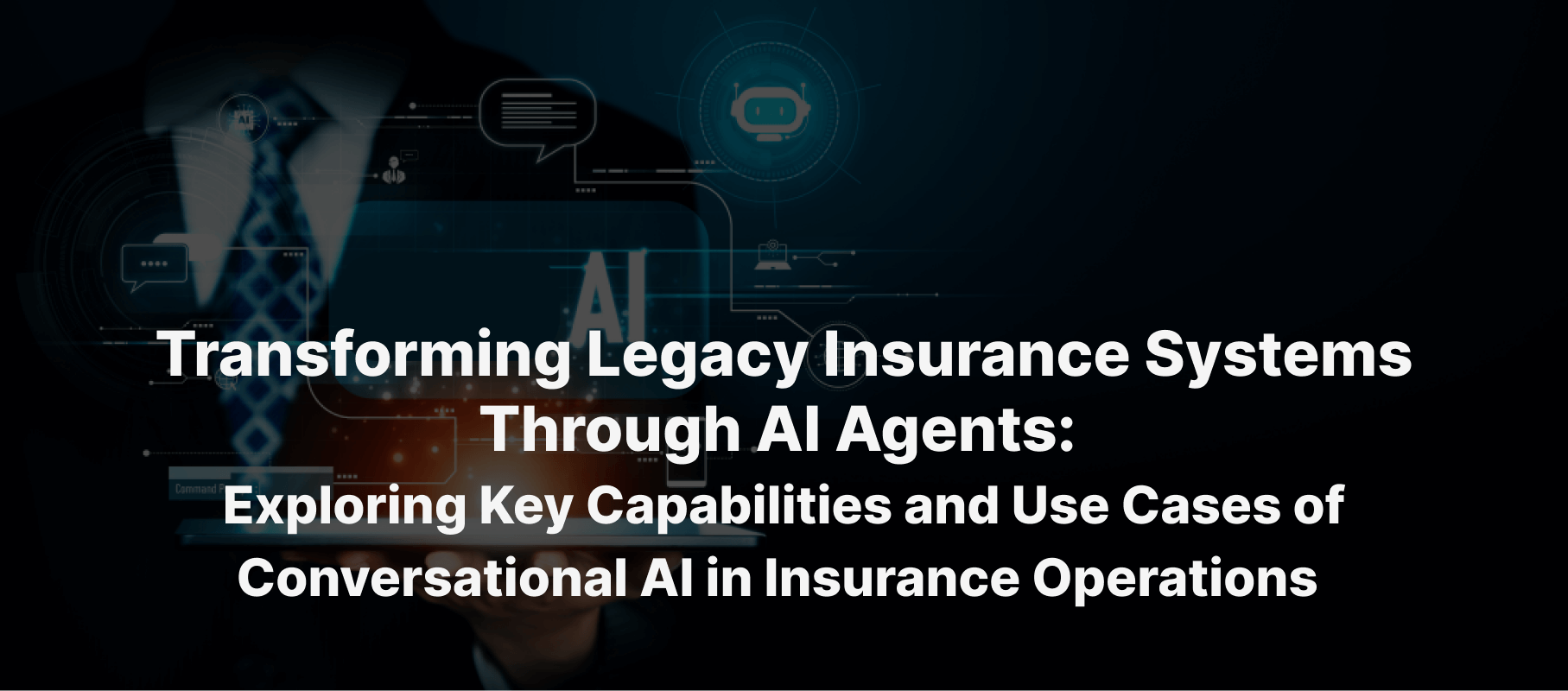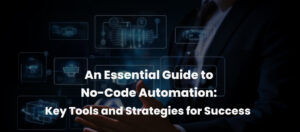A Beginner’s Guide to Understanding Enterprise Content Management (ECM) Solutions
Introduction
Is your company facing bottlenecks due to inefficient content workflows?
The reason is that outdated systems and fragmented content repositories can lead to delays, increased operational costs, and frustrated employees.Regardless of the industry, as businesses become increasingly digitised, many still struggle to manage their information effectively.
To overcome these specific challenges and hazards, demand a scalable and tailored enterprise content management (ECM) solution. With a reliable ECM platform, a business can easily manage its information digitally in a central location, use it to achieve goals and support its processes.
In this blog, we’ll explore the essential attributes, importance, and processes of modern ECM solutions and choose the right ECM platform to ensure your organisation remains efficient and competitive in an increasingly digital world.
Let’s dive in and transform how you manage content.
Challenges of Managing Content in an Organisation
As an organisation begins to expand, it produces more data, making it essential to handle and manage the growing amount of information effectively. However, the management of data becomes complex due to various factors, such as
- increased volume,
- diverse formats, and
- the need for quick access and security.
These challenges highlight the critical need for robust ECM systems to streamline content management processes.
Let’s break down the persuasive challenges of content management in an organisation.
Content Silos: In organisations, each department creates its own content repositories, such as digital databases, content management systems (CMS), and physical files, without sharing them with others.
Organisations find it difficult and are forced to rely on different applications for accessing content. This results in content silos, which lead to information bottlenecks and hinder collaboration and decision-making.
Repository Fragmentation: Similar to content silos, data and documents are spread in different repositories, which makes it complex for businesses to access, manage, and use the content. The reason is that all that content is not in the same place and is scattered, which results in it not being accessed efficiently.
Limited Functionality: Many organisations use outdated CMS that cannot keep up with the evolving needs of modern businesses. The functionality of these systems lacks integration capabilities and advanced search functionalities, leading to decreased productivity.
Security Issues: Security is the major concern of every enterprise. Improper management of organisational content containing sensitive information can lead to unauthorised access and security breaches. Ensuring effective ECM solutions are integrated into an organisation that manages security and compliance with industry standards.
Manual Errors: Human activities involved in managing content can be ineffective and prone to errors. Specifically, dealing with a large volume of content can compromise the integrity of the information.
Mobile and Cloud Needs: Employees are becoming remote and mobile, but many traditional CMS solutions lack mobile access and cloud integration. This makes dealing with the content difficult, limiting remote work and mobile device efficiency.
Note: A scalable enterprise content management solution can cross all these borders by integrating all content management needs into a unified platform, enhancing efficiency, security, and accessibility.
Is your organisation struggling with scattered content and inefficiencies? Explore efficient ECM solutions that centralise business content in one secure location, enhancing collaboration, accessibility, and data protection for organisations of all sizes.

What Is Enterprise Content Management?
Enterprise content management (ECM) is an anchor for organisations that ensures stability and control over their information. It mainly assists enterprises in storing, organising, managing, and distributing content throughout its lifecycle.
ECM tools and strategies help enterprises simplify, enhance, and streamline operations. As technology advances, content also transforms; ECM also deals with that content, including documents, spreadsheets, images, videos, contracts, and other documents.
The enterprise content management platform handles both structured and unstructured data. Structured data refers to data that is arranged in the right format and dissected into parts. Unstructured data is totally unpredictable and spreads into different formats and locations, making it difficult to search, manage, and access valuably.
Note: Systemically, ECM dealt with Gathering -> Organising -> Managing information.
Why Is ECM Important?
The main goal of comprehensive enterprise content management is to eliminate paper-based tasks and automate business processes while centralising and securing all business content in one location. Traditional ECM platforms support only limited functionality and allow only static data management such as archival, document storage and collaboration.
Whether a startup or a large company, it’s inundated with data and documents. Without a unified and effective way to manage this content, businesses can face potential operational challenges.
Let’s delve into the importance of ECM solutions and highlight why they are crucial for modern organisations.
Centralised Content Management
An integration of substantial enterprise content management solutions in an organisation facilitates a centralised approach to managing content. It centralises and organises data into one place, ensuring that content is easily accessible and secured.
Simplified Document Management
An ECM solution simplifies document management by automating the process through document capture, version control, storage, and collaborative tools. This approach maintains accuracy and easy access to multiple documents, reducing the manual workload and minimising the risk of errors.
Reduces Operational costs
With a prominent enterprise content management system, you can drastically deduct the operational costs of an organisation through.
- Eliminating all outdated and old data versions of documents
- Reducing the printing cost and unnecessary expenses associated with storage, search and management.
- Removing the usage of physical materials (paper-based documents) and digitising those documents to send and access across the enterprise.
Improved Collaboration
An ECM solution helps with team collaboration within the organisation by unifying the content in a central repository. This helps employees be in the same place as the content. This reduces confusion among everyone, makes documents easy to access, and streamlines workflow.
Increase Productivity
Since the ECM solution effectively manages, accesses, and retrieves documents, it allows employees to focus on more strategic tasks. This approach prevents human errors, manual processes, and time spent finding and retrieving relevant content.
For example, an insurance company may delay claim processing due to scattered documents, which leads to administrative costs and customer dissatisfaction. With the help of the ECM solution, insurance companies can access and manage their claim documents from a central location, streamline the claims review and approval process, and reduce processing time.

Signs your Organisation Needs an ECM Solution
Modern ECM platforms go beyond storage, integrating intelligent capture and AI-driven workflows to efficiently process and manage high volumes of documents, enhancing organisational efficiency. This approach can’t be addressed by outdated or traditional content management systems.
Here are signs that your organisation needs ECM.
Processes Get Stuck
Imagine a scenario where invoice approvals are delayed because documents are misplaced or lost. An ECM solution can streamline the process by digitising and organising invoices, ensuring timely payments.
Traditionally, manual document processing and slow workflow management create inefficiency, time-consuming and significant delays in simple and routine tasks, such as getting approvals and processing documents.
When your business processes frequently get stuck or delayed, it is an exact sign that your enterprise requires robust ECM solutions. An ECM system automates workflows, making sure documents move smoothly from one step to the next, eliminating delays and improving efficiency.
Difficulty in Finding Documents
Every CXO and decision-maker aims to access the necessary documents promptly in a business environment. This enables efficient decision-making, greater collaboration, better customer service, and strategic planning. But what if your enterprise is struggling to locate important documents with traditional ECM solutions?
Paper records, scattered content, and decentralised digital files can cause delays and frustration for the organisation. Finding and retrieving documents and files takes more time than expected, which is an essential sign that your enterprise requires reliable ECM systems.
An enterprise content management solution centralises documents, making them easily searchable with advanced search functionalities. It also facilitates the ability to retrieve any document instantly by reducing downtime and boosting effectiveness.
Regulatory Compliance Needs
If your industry is highly regulated and has many rules to follow, adapting to those regulations can take more time. It can also be difficult for your organisation to keep its documents organised and comply with them. That’s when ECM functionality comes into play.
ECM solutions help organise and protect your content, ensure you follow the rules, and avoid any fines or legal problems. They automate compliance tracking and ensure up-to-date documentation, helping your organisation stay compliant with minimal effort.
Frequent Version Control Issues
Version control issues are unchecked in traditional ECM functionality, leading to potential errors and confusion. Multiple team members are working on different versions of the same document can cause significant problems. This approach results in inconsistencies and mistakes in your organisation’s processes.
Efficient ECM solutions can easily track and store multiple versions of files and documents. With their advanced version control capabilities, they ensure information accuracy, effectively manage document changes and revisions and minimise the risk of data loss or unauthorised changes.
Limited Collaboration Capabilities
Collaboration challenges on content projects can lead to duplicate work and miscommunication. ECM systems offer scalable collaboration capabilities with multiple users and the ability to edit documents. They allow everyone to access documents in one place, share them instantly, and use tools to work together better, leading to quicker project completion.
Note: Transitioning to an ECM system not only resolves these common issues but also drives productivity and operational efficiency.
Is your enterprise facing issues with data silos, compliance risks, or inefficient document processes? Choose a solution provider that offers a modern and scalable ECM platform to automate workflows, ensure data security and optimise your content management today!

Are Enterprise Content Management and Document Management the Same or Different?
This is a common question, and confusion often arises among readers, businesses, and decision-makers. To clarify, both solutions help organisations manage their information digitally to achieve business goals and make better decisions.
ECM organises all types of content, whether structured or unstructured, in one place. Whereas document management helps enterprises only store, organise and safeguard documents. Also, it dealt only with structured documents (forms, spreadsheets).
ECM is a large-scale plan that ensures all your content is efficiently managed and easily accessible, and document management is just a part of the whole plan. The terms may seem different, but both document management comes under ECM functionality.
Key Takeaway: ECM encompasses document management, but document management alone does not cover the full scope of ECM.
Benefits of Enterprise Content Management
According to statistics, By 2032, the global Enterprise Content Management (ECM) market is expected to reach $150.97 billion. It is evident that ECM serves as the foundation for modern organisations and business leaders.
Enterprise Content Management (ECM) solutions offer numerous benefits that can transform how organisations access and manage their content and documents. Choosing an ECM is about lowering risks and optimising productivity, operational efficiency, and customer satisfaction.
Let’s discover the benefits of ECM solution
Streamlines Business processes
From daily operations to long-term strategies, the efficacy of your business processes depends on how information flows through your company. The reason is that the success of business processes is essential for the success of your organisation.
ECM solutions automate repetitive tasks and workflows, thereby streamlining business processes. This ensures that documents move through the necessary approval stages efficiently, reducing bottlenecks and improving overall productivity.
Minimising Risks
It is difficult to ensure that every department adheres to regulatory compliance in organisations, but ECM effectively guarantees this process. It helps minimise the risks associated with data breaches and compliance violations.
Comprehensive ECM systems secure sensitive information and mitigate risks such as software misconfigurations, migration errors, and inadequate access controls.
Control Over Documents
Traditionally, managing multiple versions of documents was challenging, leading to higher costs and potential issues when editing and managing various copies simultaneously. Access to documents was often restrictive, making it difficult for departments to retrieve the necessary information remotely.
An enterprise content management solution allows effective version control over documents by centralising all relevant and important information. These capabilities of ECM ensure that only the most up-to-date information is used and that all document changes are tracked.
Improve Customer Service & Enterprise experience
Manual processing of paper will drastically decrease the customer experience, negatively impacting the company’s reputation. ECM solutions enable quick and easy access to content. They improve the customer experience through quicker processing, accelerated delivery, and superior quality management.
Modern ECM solutions result in an incompatible user experience across multiple devices, so employees can access content from any device at any time. They also offer cloud access and customisation options, including predefined workflows and form layouts, which lead to improved engagement and greater satisfaction for both customers and employees.
Better decision-making
ECM solutions simplify the process of content access, which encourages employees to make data-driven decisions. It offers unlimited access to information from any device centralises data across departments and automates document management. This allows users to preview documents, approve workflows, and complete tasks remotely.
ECM systems integrate various software into a single system, eliminating time spent searching through multiple platforms. Additionally, ECM services streamline document retrieval and task management, enabling faster, more informed decisions.
Key Takeaway: ECM empowers organisations to concentrate on their long-term goals, core activities and strategic growth. As a result, businesses become more agile, informed, and customer-centric.
3 Effective Approaches to ECM Implementation
Implementing a pioneering enterprise content management system is a look-forward initiative in an organisation. To achieve this, it is required to have a clear strategy, proper planning, and collaboration across all departments. By effectively approaching ECM implementation, these organisational readiness levels are achievable.
Key ECM implementation approaches are
Launch a Pilot project
The ECM platform’s strategies undoubtedly streamline operations. However, for organisations just beginning to implement ECM, it is advisable to start with small steps towards each required project.
It means that applying the ECM solution in inconsequential areas will help enterprises easily understand and make necessary adjustments before expanding to broader implementation.
Moreover, this approach also allows you to identify potential issues and refine processes, and a well-executed pilot project ensures the ECM system meets organisational needs effectively.
Provide Comprehensive Employee Training
Even with reliable enterprise content management, employees may struggle to adopt its capabilities and functionality initially. Without adequate training, employees might become frustrated with the new solution, potentially leading to suboptimal results and project failure.
Proper training is essential for the successful adoption of an ECM system. Ensure that all employees understand how to use the new system and its benefits, and provide ongoing training support to address any challenges that arise during the transition phase.
Establish a Content Workflow Blueprint
Begin with clear content handling procedures to standardise how content are created, stored, and accessed. ECM should support your content from conception to completion. It should enable seamless changes between phases and guarantee effective and uniform content management throughout the entire content life cycle.
Note: Applying these approaches does not guarantee that no issues will arise, but they can help organisations ensure a seamless and successful ECM implementation. They assist in mitigating risks, fostering user adoption, and maximising the system’s benefits, ultimately driving better business outcomes.
Process of Enterprise Content Management Solution
Adopting a robust ECM solution is essential for enterprises facing inefficiencies with traditional content management processes. Moreover, it is also important to choose the right and flexible enterprise content management solution that encloses the comprehensive ECM process.
Enterprise content management processes are:
Capture
Advanced and modern ECM functionality effectively captures information from any source, from physical to digital formats and any other formats, making it easier to index and retrieve. It leverages AI mechanisms to organise documents and extract information automatically.
Management
Governing and managing the captured data and making it easier to search. The ECM solution automates the process of organising business tasks and unifies all the scattered information. This enables the organisation to enhance productivity, make better decisions, and optimise overall workflows.
Storage
ECM ensures a safe storage environment by facilitating cloud and on-premises options that protect and secure content. It entails backup support and safe destruction according to legal standards.
Integration
ECM functionality can be easily integrated with other business applications. It also works seamlessly with existing systems to streamline workflows and improve efficiency. Without requiring custom coding, ECM solutions enable smooth data synchronisation, ensuring that all systems work together effectively.
Usability
An enterprise content management solution employs user-friendly interfaces that easily allow access to information. It is also integrated with secure and personalised mobile-friendly access, where users can easily navigate, interact and access the content anytime and anywhere.
Smart Analysis
The ECM solution and its tools help enterprises evaluate the process using real-time analytics and dashboards. This offers visibility into how the system is working without any additional tools or help from IT teams, enabling your organisation to make quicker decisions.
Key Takeaway: ECM solutions can enhance operations, improve productivity, and ensure regulatory compliance by capturing, managing, storing, integrating, making content accessible and measuring its impact.

Struggling with integration challenges across your systems? Discover a cloud-enabled platform that simplifies complex integrations and streamlines content management that transforms your operations with seamless, scalable solutions

Choosing the Right Enterprise Content Management Solution
Adopting an ECM solution is a strategic move towards achieving a more organised, efficient, and compliant business environment. However, it is important to note that choosing the right ECM system that meets your company’s goals is also important.
A streamlined and intuitive enterprise content management system platform is needed to improve and achieve productivity, compliance, and collaboration.
Let’s explore the criteria for selecting the right ECM platform for your organisation:
Scalability
The first criterion every enterprise needs to consider is a scalable ECM solution. As the organisation grows, so does the volume of content. A robust ECM platform ensures long-term viability, adapts to evolving requirements, and maintains high performance without compromising efficiency.
User-Friendly Interface
Select an ECM solution that has an intuitive interface that allows employees to navigate, upload, and retrieve documents without any technical expertise. Also, go with an ECM platform that ensures seamless adoption across your organisation.
AI-ML Enabled
An advanced enterprise content management solution uses AI and ML to automate routine tasks and provide valuable insights. This helps businesses make more informed decisions, streamline operations, and enhance overall efficiency. Besides, AI and ML improve document capture by enhancing data separation, classification, and extraction.
Reputable Solution Provider
Choosing a reputable modern ECM solution provider can help understand modern business needs. This not only lowers risks but also ensures you have the satisfaction of working with well-known and reliable industry experts.
Cloud-centric
Always choose an ECM solution integrated with the cloud to ensure scalable storage and unparalleled content flexibility and accessibility. This reduces on-premises infrastructure costs and supports a more agile business environment.
Low code/No code
Opting for an ECM platform that should enable every employee, including non-technical users, to create and personalise applications with minimal coding. It also should support workflows that can be customised without the assistance of IT teams, allowing quicker deployment of solutions tailored to specific business needs.
SquareOne’s ECM Powered by Hyland: Scalable Content Management for Your Growing Enterprise
Modern enterprise content management (ECM) is essential for organisations to simplify content processes, boost security, and enhance efficiency. SquareOne, a profound enterprise content management solution provider in the Middle East, understands the difficulties of traditional and outdated content management systems. They offer contemporary solutions that eliminate paper-based work and manual processing, evolve with technological progress and foster business agility.
Hyland’s ECM solutions offered by SquareOne are:
Alfresco: A modern cloud-native platform with advanced content management, process automation, and governance capabilities. It enhances accessibility to content, allowing users to manage and retrieve information seamlessly without needing to switch between applications.
Onbase: A centralised platform that digitises and streamlines manual processes related to organising, storing, and sharing documents. It securely stores important business content in one location and delivers relevant information to businesses efficiently.
Final Note
Adopting a scalable ECM solution helps eliminate manual tasks, reduce paper usage, and streamline workflows. It leverages cloud technology, AI, and ML with centralised repositories to improve data governance and enable more effective decision-making for organisations.
At Square One, the professional team offers leading ECM services to integrate the platform seamlessly for your organisation. Their solution modernises the entire content lifecycle and provides tailored tools and features suitable for various industries.
Still facing issues with content and document management to boost your business process? Connect with SquareOne today!
FAQs
ECM stands for Enterprise Content Management. It refers to the advanced strategies, tools, and technologies used to capture, manage, and store organisational content and documents.
The difference between ERP and ECM is that enterprise resource planning (ERP) systems manage core business functions like finance and HR. In contrast, enterprise content management (ECM) solutions focus on organising and managing documents and content across the organisation.
The ECM functionality modernises content management and technology strategy for enterprises. The key components of ECM are
- content lifecycle management
- workflow management
- document management
- information governance
- workflow automation
- content collaboration tools
No, ECM is not an ERP. ERP is responsible for the management of the organisation’s overall business procedures, whereas ECM is specifically focused on the management of content and documents within the organisation.
The ECM process includes capturing, managing, storing, and retrieving content. Using an ECM solution streamlines content workflows and ensures secure, organised access to business information.
In the HR department, handling large volumes of employee records and onboarding documents can be challenging for HR teams. With effective ECM functionality, it addresses these borders by managing and securing these records, ensuring efficient retrieval and reducing administrative burden.
The purpose of an enterprise content management system is to help a business gather, organise, store, and share important information with its employees, stakeholders, and customers.


















